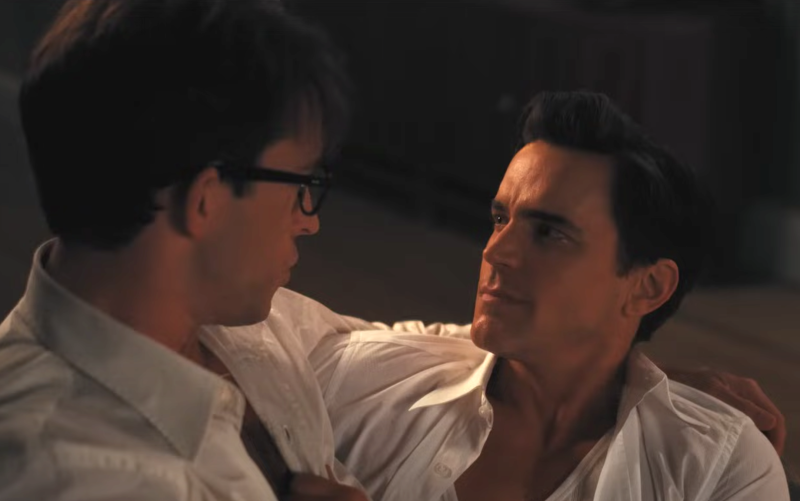We’ve seen bad love interests before. They’re handsome, smarmy and casually abusive. These characters are usually relegated to the sidelines as examples of who not to pursue. That is, unfortunately, not the case in Fellow Travelers, a new eight-part Showtime adaptation of Thomas Mallon’s 2007 novel.
Showtime’s ‘Fellow Travelers’ Offers a Soupçon of Sexy Sex and a Heap of Gay Misery

Fellow Travelers is an epic love story that, at its core, hinges on gay lovers snatching moments together at sporadic points throughout their lives. More than half of the series, however, is set in McCarthy-era Washington, D.C. That’s an inherently difficult setting for any gay couple to thrive in, but the struggles faced by this pair would be far easier to watch if one of them didn’t behave like a self-centered, self-righteous jackass most of the time.
One gets the sense that the producers of Fellow Travelers wanted said jackass, Hawk Fuller (played by Matt Bomer), to come across as a flawed and complicated man who has no choice but to keep his lover Tim Laughlin (Jonathan Bailey) at arm’s length because of the difficult times they’re living through. Instead, Hawk comes off as casually cruel, on a nonstop power trip and interested only in gratifying his own sexual needs and ego. (He’s basically Jon Hamm in Bridesmaids, without the laughs.) Worse, Hawk is so dispassionate that not only is it impossible to feel invested in him as a character, it becomes difficult to care about submissive, moon-eyed Tim either. As a viewer, watching Tim willingly wolf down emotional scraps from Hawk, instead of finding someone better, remains frustrating for the entire first half of the series. (Hot bod aside, what does Tim even see in this guy?)
It’s true that the folks behind this adaptation are a who’s-who of queer pop culture content. The series was created by Ron Nyswaner (Philadelphia). And Nyswaner and Bomer executive produced with Robbie Rogers (My Policeman) and Daniel Minahan (Halston, American Crime Story: Versace). But oh, what a difference it might have made had there been someone working on this series who had more experience presenting stories about LGBTQ folks who weren’t inherently doomed to tragedy in one form or another.
Sure, the (apparently also miserable) novel (I haven’t read it) dictates the circumstances. But some extra stolen moments of joy between our two protagonists would have gone a long way to explaining why they’re so into each other in the first place. As it stands, the only time they seem even vaguely happy together is in the bedroom. (Bravo to all of the steamy man sex in this series — that’s one of the things it actually does do with gusto.)
Fellow Travelers is not all bad. It’s an aesthetically pleasing period piece that gets much better in its second half. In the first, it does an excellent job of capturing the anxiety of being a member of the gay community during the Lavender Scare of the 1950s. The sneaking around, the paranoia, the personal and professional risks at hand make for stressful viewing, but it’s certainly an interesting reflection of what the LGBTQ+ community went through during the McCarthy hearings.
The series is also aided by side characters who are worth rooting for. In particular, Black journalist Marcus (Jelani Alladin) and his lover Frankie (Noah J. Ricketts) who experience all of the hardships of Hawk and Ted with the added burden of dealing with flagrant racism at every turn.

Thankfully, Episodes 6 through 8 offer significant payoffs. Hawk and Tim get much less arduous to watch once the show moves into the 1960s. Marriage and family life turns Hawk into a more sensitive human, while Tim grows a spine in the process of joining the Army and later, becoming an anti-war activist. Allison Williams also puts in a wonderful — and impressively sympathetic — performance as Hawk’s wife Lucy, as she struggles to sustain a stable home despite the secrets her husband insists on keeping from her.
Episodes 7 and 8 move to San Francisco in the late ’70s and early ’80s, meaning — yay! — there’s suddenly a healthy amount of Sylvester on the soundtrack. Don’t get too excited about the potential for joy though — the story remains dour as ever, hitting the Harvey Milk and George Moscone murders before ploughing face first into the AIDS crisis. Even a foxy little trip to Fire Island manages to go depressingly off the rails. (At least Frankie and Marcus are around and still being cute as hell.)
Truth be told, this series would have benefited from being about three hours shorter. The McCarthy-era portion of the show is unnecessarily protracted — something that comes into stark relief when later episodes skip through years and years at a time.
If you’re someone who (for some reason) can’t get enough tragic gay stories in your life, you will absolutely love the way Fellow Travelers revels in its own sepia-toned misery. If a series of steamy sex scenes is enough to get you through hours of doom and gloom, then by all means, have at it. But for everyone else? Consider this series a kind of endurance test, one in which characters respond to small gifts by saying things like, “I can’t bear being this happy.”

‘Fellow Travelers’ begins streaming on Showtime and Paramount+ on Oct. 27, 2023.

